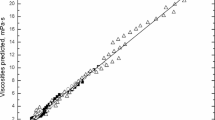Abstract
IN 1940 Hinton1 put forward a theory which was capable of explaining quantitatively many of the phenomena associated with the formation of high solids pectin gels. More recently, the assumptions on which Hinton based his theory have been criticized and an alternative explanation suggested which is more in keeping with current theories of the properties of macromolecules2. Neglecting the small variation in the degree of dissociation of pectin with concentration1,3, for a given pectin in a gel of specified soluble solids content and pH, both theories indicate a linear relationship between gel strength and pectin concentration. However, a review of a number of the published curves relating the gel strength and the pectin concentration shows that when the strength is measured within the elastic limits of the gel and is expressed in units proportional to an elastic modulus, in each case the curve obtained is convex to the pectin concentration axis4–11 (gel strengths measured by means of the ridgelimeter9–11 may be converted from percentage sag to shear moduli by means of the curve given by Owens and Maclay12). Similar curves have been obtained by some workers measuring the breaking strengths of the gels13–15, although in some instances a linear relationship was found16,17.
Similar content being viewed by others
References
Hinton, C. L., Biochem. J., 34, 1211 (1940).
Grover, D. W., Chem. and Ind., 1216 (1952).
Harvey, H. G., J. Sci. Food and Agric., 1, 307 (1950).
Lampitt, L. H., and Money, R. W., J. Soc. Chem. Ind., 56, 290,T (1937).
Lampitt, L. H., and Money, R. W., J. Soc. Chem. Ind., 58, 29,T (1939).
Hinton, C. L., D.S.I.R. Food Investigation, Special Report NO. 48, London (1939).
Owens, H. S., Porter, O., and Maclay, W. D., Food Indust., 19, 606 (1947).
Säverborn, S., Dissertation, Upsala (1945).
Joseph, G. H., and Baier, W. E., Food Technol., 3, 18 (1947).
Lockwood, H. C., Analyst, 80, 315 (1955).
Olliver, M., Wade, P., and Dent, K. P., Analyst, 82, 127 (1957).
Owens, H. S., and Maclay, W. D., J. Coll. Sci., 1, 313 (1946).
Olsen, A. G., Ind. Eng. Chem., 25, 699 (1933).
Stuewer, R., Beach, N. M., and Olsen, A. G., Ind. Eng. Chem., Anal. Ed., 6, 143 (1934).
Myers, P. B., and Baker, G. L., Univ. Delaware Agric. Exp. Sta., Bull. 149 (1927).
Mottern, H. H., and Karr, E. E., Fruit Prod. J., 25, 292 (1946).
Bender, W. A., Anal. Chem., 21, 408 (1949).
Olliver, M., Wade, P., and Dent, K. P., J. Sci. Food and Agric., 8, 188 (1957).
Author information
Authors and Affiliations
Rights and permissions
About this article
Cite this article
WADE, P. Relationship of the Strength of High Solids Pectin Gels to the Concentration and Jelly-forming Capacity of the Pectin Present. Nature 180, 1067–1068 (1957). https://doi.org/10.1038/1801067b0
Issue Date:
DOI: https://doi.org/10.1038/1801067b0
- Springer Nature Limited
This article is cited by
-
Relative viscosity and concentration
Rheologica Acta (1962)





